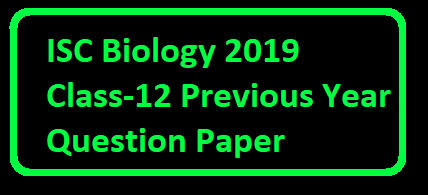ISC Biology 2019 Class-12 Previous Year Question Paper Solved for practice. Step by step Solutions with Part-I, and II (Section-A,B and C). By the practice of ISC Biology 2019 Class-12 Solved Previous Year Question Paper you can get the idea of solving. Try Also other year except ISC Biology 2019 Class-12 Solved Question Paper of Previous Year for more practice. Because only ISC Physics 2019 Class-12 is not enough for complete preparation of next council exam. Visit official website CISCE for detail information about ISC Class-12 Biology.
ISC Biology 2019 Class-12 Previous Year Question Paper
-: Select Your Topics :-
Previous Year Question Paper ISC Biology 2019 Class-12
Maximum Marks: 70
Time allowed: Three hours
(Candidates are allowed additional 15 minutes for only reading the paper. They must not start writing during this time)
- This paper comprises two parts – Part I and Part II.
- Answer: all questions.
- Part I consists of one question of 20 marks having five subparts.
- Part II consists of Sections A, B and C.
- Section A consists of seven questions of two marks each.
- Section B consists of seven questions of three marks each, and Section C consists of three questions of five marks each.
- Internal choices have been provided in two questions in Section A, two questions in Section B and in all three questions of Section C.
- The intended marks for questions or parts of questions are given in brackets [ ].
Part-1 (20 Marks), Previous Year Question Paper ISC Biology 2019 Class-12
answer all question
Question 1.
(a) Answer: the following questions briefly and to the point: [8 × 1]
(i) Name the antibody which is most effective in allergies.
(ii) What is the function of GEAC?
(iii) What is a clone?
(iv) What do detritus food chains begin with?
(v) Give the full form of EFB.
(vi) How many chromosomes are present in meiocytes of a fruit fly?
(vii) Name the common ancestor of apes and man.
(viii) Give the scientific term used for the preservation of germplasm at a very low temperature.
(b) Each of the following sub-parts, (i) to (iv) has four choices. Choose the best option in each case: [4 × 1]
(i) Eyelids in human foetus separate in :
(1) 14 weeks
(2) 16 weeks
(3) 24 weeks
(4) 40 weeks
(ii) Study the given monohybrid cross:

A test cross for this Fj will be:
(1) Tt × TT
(2) Tt × tt
(3) Tt × Tt
(4) TT × tt
(iii) Montreal Protocol aims at:
(1) Reduction of ozone-depleting substances
(2) Biodiversity conservation’
(3) Control of water pollution
(4) Control of CO2 emission.
(iv) In the given pedigree chart, the trait shown is:

(1) Autosomal dominant
(2) Autosomal recessive
(3) X-linked
(4) Y-linked
(c) Give one significant contribution of each of the following scientists: [4xl]
(i) Wallace
(ii) R. Mishra
(iii) G. Gamow
(iv) Sanger
(d) Define the following: [2 × 1]
(i) Carrying capacity
(ii) Homologous chromosomes
(e) Give a reason for each of the following: [2 × 1]
(i) Bagging is essential in artificial hybridisation.
(ii) Climax stage is achieved quickly in secondary succession as compared to primary succession.
Answer:
(a)
(i) Immunoglobulin E
(ii) Genetic engineering approval committee’s function is to examine the validity of GM research and to inspect safety in use of GMO’s for the public.
(iii) The offsprings which are produced are genetically and morphologically identical are called clones.
(iv) Scavengers
(v) European Federation of Biotechnology
(vi) 8
(vii) Dryopithecus
(viii) Cryopreservation
(b)
(i) 24 weeks
(ii) Tt × tt
(iii) Reduction of ozone-depleting substances
(iv) Autosomal recessive
(c)
(i) Divided the Earth into Biogeographical regions
(ii) Father of Indian Ecology
(iii) Triplet nature of codon
(iv) DNA sequencing
d)
(i) Habitats are species specific and have resources upto a limit that can support maximum number of individuals to grow and reproduce beyond which no further growth is possible.
(ii) Homologous chromosomes are chromosome pairs that are similar in length, gene position and centromere location.
(e)
(i) So that no foreign pollen may fall on the stigma.
(ii) Because some seeds and underground parts of plants are already present
Part-II
Section-A (14 Marks), Previous Year Question Paper ISC Biology 2019 Class-12
(Answer: all questions)
Question 2.
Enumerate any four essential features of good and effective poultry farm management practices. [2]
Answer:
1. Comfortable, well ventilated, dry, clean and properly lighted house.
2. Poultry house should be protected from rats, cats, etc
3. Good drainage system is essential.
4. Birds of different age should be kept separately.
Question 3.
What is a single cell protein? How is it significant for human welfare? [2]
Answer:
It is one of the alternative sources of proteins for animal and human nutrition
Significance
– Used as protein rich supplement of human diet.
– Reduces pressure on agriculture.
– Reduces environmental pollution.
Question 4.
(a) List four reasons for drug addiction. [2]
Or
(b) List four effects of alcoholism on human health.
Answer:
(a)
1. Curiosity, temporary escape and mental relaxation.
2. Inability to adjust to stresses, strains and anxiety.
3. Differences are shown by members of family and drudgery.
4. Drugs alter perception, behaviour & consciousness.
Or
(b)
1. Loss of judgement will power and self-confidence.
2. Amnesia
3. Fatty liver syndrome. In advance, stage causes liver cirrhosis.
4. Effects heart, kidney and stomach.
Question 5.
State four features of flowers pollinated by insects.
Answer:
Flowers large and brightly coloured.
Pollen grains covered with pollen kit, rough and sticky.
Sepals and petals well developed.
Nectar gland present.
Question 6.
What is reproductive fitness? Explain it with the help of an example. [2]
Answer:
Those who are better fit in the environment leave more progeny than others. This is called reproductive fitness.
Example:
Oyster lays 60-80 million eggs in a single spawn. If all the eggs hatch and young ones survive, it will be a very huge number of oysters which will be formed on the earth. All of them do not survive only those who are fit in the environment can survive rest die.
Question 7.
Give one significant difference between primary lymphoid organs and secondary lymphoid organs. Give one example of each. [2]
Answer:
Primary lymphoid organs – In these organs, immature lymphocytes differentiate into antigen- sensitive lymphocytes e.g., Bone marrow, Thymus Secondary lymphoid organs – The matured lymphocytes undergo proliferation and differentiation e.g., lymph nodes, spleen, tonsils.
Question 8.
(a) Explain the term biofortification. How is this technique useful for the production of ‘ golden rice? [2]
Or
(b) Write a short note on Electrophoresis.
Answer:
(a) Breeding of crops with higher levels of vitamins and minerals or higher proteins and healthier fats is called biofortification.
Golden rice has five times more iron than common varieties.
Or
(b) It is a technique commonly used in the lab to separate charged molecules like DNA, according to size.
There are two types of gels used for electrophoresis.
– Agarose gel for separation of medium and large-sized nucleic acids
– Polyacrylamide gels for separation of proteins and purification of enzymes or separation of DNA fragments.
Section-B, (21 Marks) Previous Year Question Paper ISC Biology 2019 Class-12
(Answer: all questions)
Question 9.
Explain the evolution of long neck of giraffe according to Charles Darwin. [3]
Answer:
Darwin explained evolution of long neck of modem Giraffe by presuming existence of variability in length of neck and legs in ancestral population of Giraffe. Long necked giraffe with long fore legs were more successful in reaching soft leaves of trees for feeding. Therefore, natural selection favoured long neck progeny generation after generation
Question 10.
(a) Draw a labelled diagram of the T.S. of a mature anther. [3]
Or
(b) Draw a labelled diagram of the internal structure of human ovary.
Answer:
(a)


Question 11.
Describe the structure of a nucleosome with the help of a well-labelled diagram.
Answer:
Nucleosomes are submicroscopic units of chromatin named by Oudet et al. Nucleosome is about 11 nm in diameter and 5.76 nm in height. It is formed of core particle of histone octamer lightly wrapped with 1.73 circles of DNA with 146 nucleotide pairs, two adjoint nucleosomes are connected by linker DNA or interbreed DNA,

Question 12.
(a) Explain the Rivet Popper hypothesis. [3]
Or
(b) Define:
(1) Standing crop
(2) Stenothermal organisms
(3) Niche
Answer:
(a) According to Rivet Popper hypothesis by Paul Ehlrich describes the effect of loss of biodiversity on ecosystem. Removal of rivets (species) by passengers on a plane may not affect safety of flight initially but as more and more rivets are removed, it becomes weak. Removal of rivets of a critical part like wing (species performing major ecosystem functions) will pose a very serious immediate threat to the safety of the flight. In an ecosystem various species act as rivets and role of each species is important and well defined.
Or
(b) 1. The total dried biomass of living organisms present in a given environment.
2. A species or living organism only capable of living within a narrow temperature range.
3. The specific area where an organism inhabits.
Question 13.
Give the biological names of the following: [3]
(i) The mould from which penicillin is obtained.
(ii) Baker’s yeast.
(iii) The microbe used to control insect larvae growing on cotton.
(iv) The microbe used to produce Swiss cheese.
(v) The fungus that is being developed as a bio-control agent.
(vi) A symbiotic nitrogen-fixing bacterium found in root nodules.
Answer:
(i) Penicillium notatum
(ii) Saccharomyces cerevisiae
(iii) Bacillus thuringienesis
(iv) Propionibacterium shermanii
(v) Trichoderma
(vi) Rhizohium
Question 14.
Explain the different types of endosperms in angiosperms. [3]
Answer:
Different types of endosperms in angiosperms are:
1. Free nuclear : It is most common type of endosperm – nuclear division of endosperm is not followed by cell wall formation and nuclei remain free e.g., coconut, water.
2. Cellular : Division of endosperm nucleus is immediately followed by cell wall formation so endosperm is cellular from beginning e.g., peperomia, villarsia Drimys.
3. Helobial : It is intermediate between cellular and helobial type. Partition develops which divides endosperm into large micropylar and small chalazal chambers e.g. vallisneria, Erimus,.
Question 15.
A homozygous pea plant with round seed coat and yellow cotyledons is crossed with another homozygous, pea plant having wrinkled seed coat and green cotyledons. [3]
(i) Give the types .of gametes produced by plants of F-generation.
(ii) Give the dihybrid phenotypic ratio with the corresponding phenotypes.
(iii) State Mendel’s principle involved in this cross.
Answer:
(i) Types of gametes = RY Ry rY ry
(ii) Dihybrid phenotypic ratio =9 : 3 : 3 : 1
(iii) Law of independent assortment : It states that two different characters or genes assort independently and enter into gametes without influencing each other.
Section-C, (15 Marks) Previous Year Question Paper ISC Biology 2019 Class-12
(Answer: all questions)
Question 16.
(a) Describe the physico chemical events that take place during fertilization in humans. [5]
Or
(b) (i) Define and give the role of amniocentesis.
(ii) Name the causative agent and give any one symptom of Gonorrhoea.
(iii) What is the significance of dispersal of seeds? Give any two points.
(iv) What are seasonal breeders? Give an example.
(v) How is the chromosome number maintained in sexually reproducing organisms?
Answer:
(a) Physical and Chemical Events of Fertilization :
These events include the following ‘ processes.
(i) Acrosomal Reaction : After ovulation, the secondary oocyte reaches the Fallopian tube (oviduct). The capacitated sperms undergo acrosomal reaction and release various chemicals contained in the acrosome. These chemicals are collectively called sperm Iysins. Important sperm lysins are
(i) hyaluronidase that acts on the ground substances of follicle cells,
(ii) corona penetrating enzyme that dissolves corona radiata and
(iii) zona lysine or acrosin that helps to digest the zona pellucida.
OptimumpH, Ca++, Mg++ ions concentration and temperature are essential for acrosomal reaction. Ca++ plays majorrole in acrosomal reaction. In the absence of Ca++, fertilization does not occur.
Due to acrosomal reaction, plasma membrane of the sperm fuses with the plasma membrane of the secondary oocyte so that the sperm contents enter the oocyte. Binding of the sperm to the secondary oocyte induces depolarization of the oocyte plasma membrane. Depolarization prevents polyspermy (entry of more than one sperm into the oocyte). It ensures monospermy (entry of one sperm into the oocyte).
(ii) Cortical Reaction : Just after the fusion of sperm and plasma membranes of oocyte, the secondary oocyte shows a cortical reaction. The cortical granules are present beneath the plasma membrane of oocyte, and release their contents including cortical enzymes between the plasma membrane and the zona pellucida. These enzymes harden the zona pellucida which also prevents entry of additional sperms (polyspermy).
(iii) Sperm Entry : At the point of contact with the sperms, the secondary oocyte forms a projection termed the cone of reception or fertilization cone which receives the sperm. The distal centriole of the sperm divides and forms two centrioles to generate the mitotic spindle formation f pr cell division. The mammalian secondary oocyte (egg) does not have centrioles of its own.
(iv) Karyogamy (Amphimixis): Sperm entry stimulates the secondary oocyte to complete the suspended second meiotic division. This produces a haploid mature ovum and a second polar body. The head of the sperm which contains the nucleus separates from the middle piece and the tail and becomes the male pronucleus. The second polar body and the sperm tail degenerate. The nucleus of the ovum is now called, the female pronucleus. The male and female pronuclei move towards each other. Their nuclear membranes disintegrate. Mixing up of the chromosomes of a sperm and an ovum is known as karyogamy or amphimixis. The fertilized ovum (egg) is now called zygote. The zygote is diploid unicellular cell that has 46 chromosomes in humans. The mother is now said to be pregnant.
(v) Activation of Egg : Sperm entry stimulates metabolism in the zygote. As a result, the rates of cellular respiration and protein synthesis increase greatly. Besides activating the egg another role of sperm is to carry DNA to egg.
or
(b)
(i) Aspiration of amniotic fluid from amniotic sac around the foetus is called amniocentesis.
Role : Used to determine
- To determine sex and sex abnormalities of developing baby.
- Genetically controlled congenital diseases.
- Gene related metabolic disorders.
(ii) Causative agent – Neisseria gonorrhoeae
Symptom – Pus containing discharge from genital ducts.
(iii) Significance of dispersal of seeds:
- Evolution of land plants.
- In establishing species in new areas by means of dispersal.
(iv) Seasonal breeders are organisms that perform breeding and have active reproductive cycles during particular breeding season e.g.. Birds
(v) in sexually reproducing organisms. chromosome number is maintained by process of meiosis in which chromosome number is reduced to half which is restored on fertilization.
Question 17.
(a)
(i) What are restriction endonucleases? Give the rules of their nomenclature.[5]
(ii) Explain the mechanism of action of restriction endonucleases that makes them suitable for genetic engineering.
Or
(b)
(I) Explain what are the desirable characteristics of an ideal cloning vector used in r DNA technology.
(ii) Describe two vectorless methods of gene transfer used in rDNA technology.
Answer:
(a)
(i) They cut DNA duplex at specific points. They are molecular scissors.
Rules : Restriction endonucleases are named by using first letter of the name of genus followed by first two letters of species from which these enzymes are isólated. All the three letters are written in italics.
(ii) Each restriction endonuclease recognises a specific palindromic base sequence in foreign DNA and cuts sugar phosphate backbone of both strands of double helix at specific points. These ends are called as sticky ends. The sticky ends of 2 different molecules of DNA cut by same restriction endonuclease arc thenjoined by ligase to form a recombinant DNA.
Or
(b)
(i) Desirable characters of an ideal cloning vector :
- Origin of replication: It is a specific sequence of nucleotides which serves as binding site for initiator protein (Helicase) to start replication. Any foreign DNA linked with vector DNA also gets replicated along with it, hence is important for maintaining the copy number of foreign DNA.
- Selectable markers : Cloning vectors must contain atleast one selectable marker or it helps in:
– detection of transformed host cells,
– Identification and elimination of nontransformed post cells,
– Isolation and growth of transformed host cells. - Cloning sites : A cloning site is a restriction endonuclease recognition site or target site in vector DNA. It has palindromic sequence of nitrogenous bases cut by a specific restriction endonuclease enzyme for insertion and linking of foreign DNA.
- Small size: A vector should be small in size because large molecules bind is break up during isolation and purification.
(ii) Two vectorless methods of gene transfer used in rDNA technology.
- Chemical mediated gene transfer: Use of chemicals like polyethene glycol (PEG) and dextron sulphate induces DNA uptake by plant protoplast
- Electroporation : Short electric impulse of high voltage causes fine transient forces in cell membrane through which foreign DNA enters into the cell.
Question 18.
(a) Give a graphic representation of carbon cycle in nature.
Or
(b) Give a graphic representation of phosphorus cycle in nature.
Answer:


Phosphorus cycle in terrestrial ecosystem
-: End of ISC Biology 2019 Class-12 Solved Previous Year Question Paper :-
Return to – ISC Class-12 Solved Previous Year Question Paper
Thanks
Please Share with Your Friends




